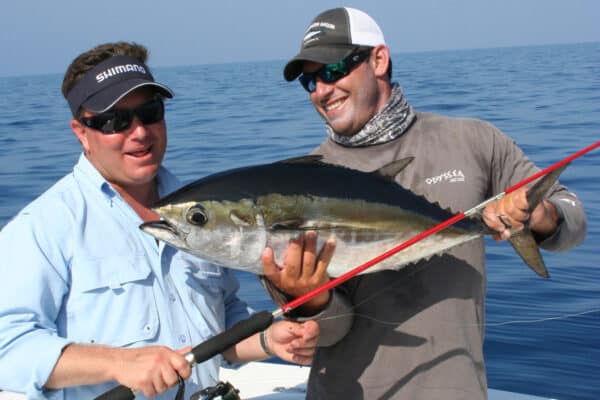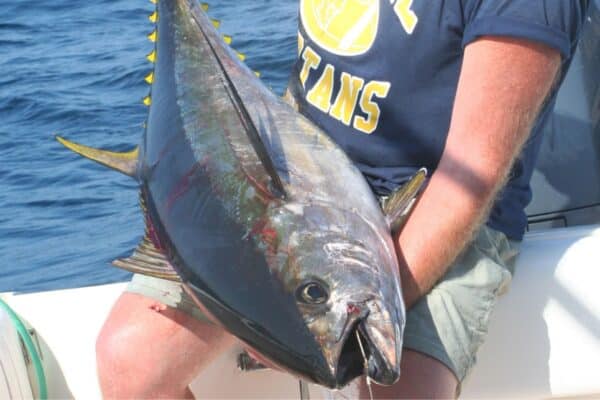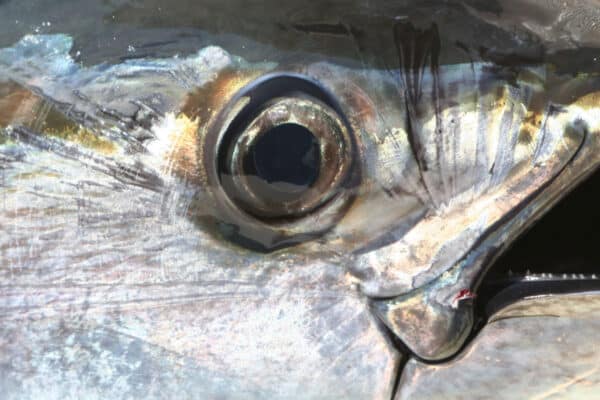
Take your skills up a notch the next time you try chunking for tunas.
Chunking for yellowfin when they move onto the Mid- Atlantic lumps is easy, right? Not so fast—anyone can throw some butterfish chunks over the side and get lucky, but if you want to out-fish the fleet you’ll need to dig into the finer points and apply some advanced tactics. We’re going to skip over the basics here, because if you don’t already know how to rig your rods and stick a bait on a hook you’re not ready for the 401 course. Assuming you already have a grip on how it works, however, paying attention to these finer points will help you catch when no one else does and load the boat when most anglers are getting a fish or two.
Focus on Multiples
The idea here is the same as with trolling: when you hook one fish you know there are more around, so don’t stop what you’re doing to focus solely on the fight. When a rod goes down your initial reaction shouldn’t be to dive on it, but instead, dive on the bucket of butterfish chunks you’ve prechopped and shovel more of those fish-attracting nuggets over the side to hold the school. Next, consider the line that got hit: was it recently deployed and close to the boat, was it 30 yards back, or was it way way back there? You were paying attention, so you do know… right?! Now try to match up your other lines. If one’s in tight and the fish was farther out, keep sending it back. If your other lines are way back and the fish was in close, crank them up post-haste and redeploy them in the hot zone.
By now you should have an angler on the bent rod. Assign someone else to keep the chunks flowing at a steady pace, and have additional crew mind the other rods while telling them where they need those baits to be. At this point you should be playing the role of a coach, talking the team members through their jobs to get multiple hookups going until it’s time to move in with the gaff. Whatever you do don’t “clear lines” unless you have Moby Dick on and you’re not willing to risk a tangle. Play it right, and often you can get a double or a triple going. In a perfect world you can hold the school at the boat and catch one after the next.
Up the Ante
Since you already have the basics down pat, we know that you know it’s often necessary to use a light leader to get the yellowfin biting on chunks. This can mean dropping to 30-pound fluoro, so many anglers leave the dock in the morning rigged up with 30 on all the lines. But (as you also know already) using 30-pound leaders makes for a very long fight on fish of any real size. And the longer the fight is the better the chance of a break-off.
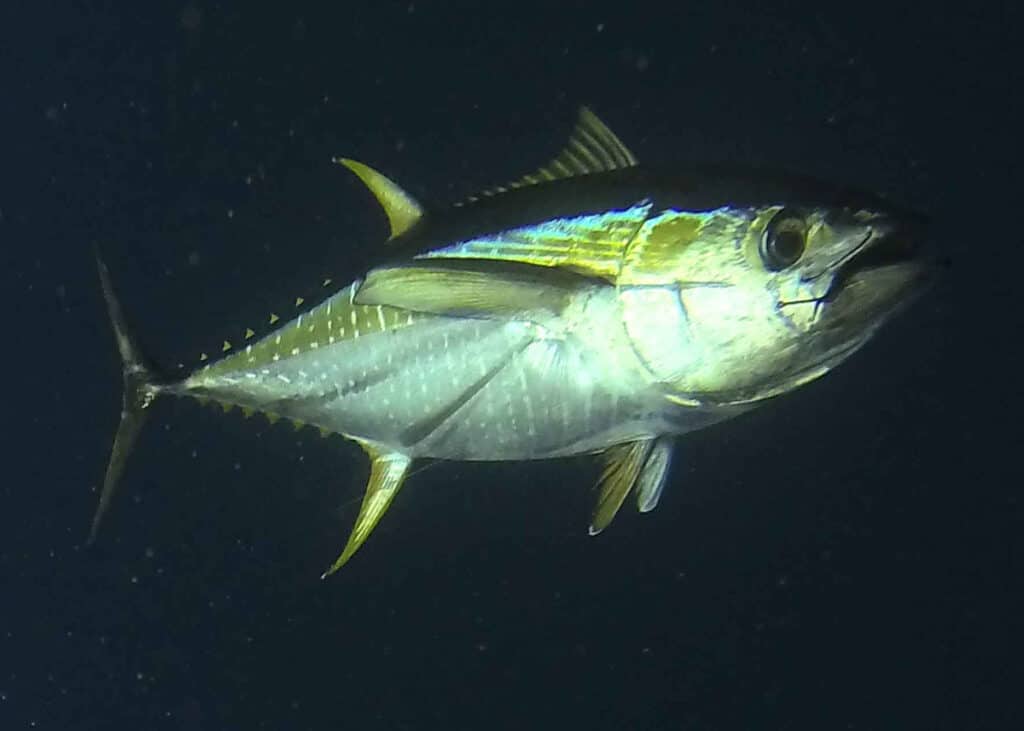
While it’s a good idea to start off light to get the ball rolling right out of the gate, don’t assume you need to continue using it to keep the action flowing. Some days, for whatever reason, the tuna just don’t seem to care the same as they do on other days. So, if they’re biting freely swap out a few leaders for 50-pound test. If they get bit, try using 80 on a couple of lines. Test the waters and see if you can get hook-ups on heavier leaders. If you can, you’ll get the fish into the kill box a heck of a lot more efficiently.
Tempt the Tuna with Tentacles
There will be days when the bites are few and far between or you’ll be competing with a big crowd that’s shoveling butterfish chunks over the side by the ton. In such cases, you need to tempt those fish with something special. For this reason alone you should never leave the dock without a box of whole squid aboard. Not giant rigging squid, the regular seven- to 10-inchers you’d usually slice up for flounder bait.
Cut the hook off a line (one with that uber-light leader we know you’re using since the bite is tough), use it to poke a hole in the tip of a squid’s mantle, then run the leader down through the squid until it comes out by the tentacles. Next, slide a half-ounce to one-ounce egg sinker over the line. Then, tie or crimp a long-shank hook back on the end. Slide the squid down until the egg sinker rests inside the tip of the mantle. If the hook is long enough and the squid is small enough, the bend of the hook will be below the end of the mantle and the point will sit exposed. Done deal. If not, push the point through the mantle just far enough to expose the barb.
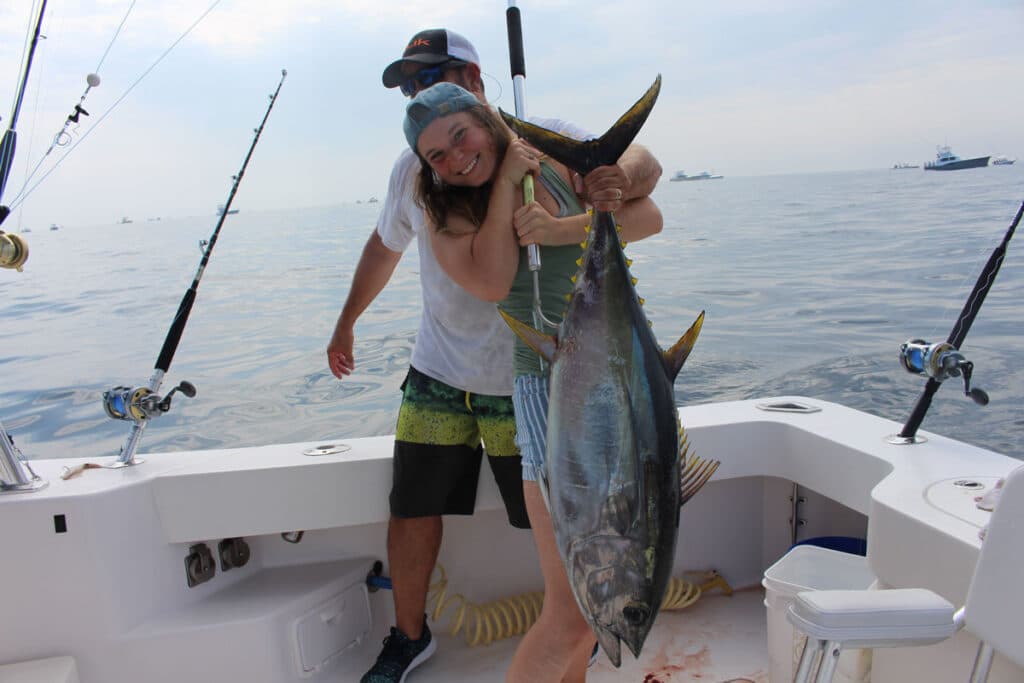
Thusly rigged you can set this bait out under a float or with additional weight and often it will get slammed before a butterfish chunk will. Better, though, is to strip it back and let it freefall. As it does, those tentacles will wiggle enticingly and trigger a violent attack far more often than a static chunk of dead fish. One note of caution, however: these are delicate baits. A missed strike of any sort means reeling up and rerigging immediately.
Okay: ready to put the rest of the boats on the dock to shame? Of course you are—apply these advanced chunking lessons and you’ll graduate to a plugged fishbox.


